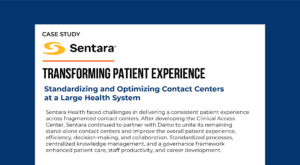How Amazon, Walgreens and Walmart are changing the landscape for online patient experience
A slew of consumer health apps from non-traditional players have hit the market lately. Traditional healthcare providers are also stepping up to meet consumer needs and preferences.
As the cost of employer-provided healthcare breaches the $20,000 a year mark for a family of four, Walmart’s corporate slogan of “Save Money. Live Better” couldn’t be more ironic. Not surprising then, that the company launched a pilot to offer a range of healthcare services to Sam’s Club members to live up to the corporate slogan.
Around the same time, Amazon announced a telemedicine app for its Seattle employees. Large employers like Amazon and Apple have dipped their toes into offering primary through on-campus clinics, while Walmart and CVS have gone the route of providing primary care services through their physical footprint of stores across the nation.
Walgreens, at the other end, is trying to build an online relationship with some of the seven million customers who walk through their stores every day. Even electronics retailer Best Buy has gotten into the act, declaring its intent to become the CTO of our households as remote monitoring devices start pervading our homes. The Geek Squad may soon be part of your care management team.
While it is early days yet, most of these non-traditional providers of healthcare are targeting a captive audience of employees and consumers. Most healthcare consumers still rely on their traditional provider relationships. In an earlier article here titled Digital front doors – the new battleground for the healthcare consumer’s attention, I discussed how the battlefield for the healthcare consumer’s attention has shifted to user-friendly online access to health care services.
What is the perceived need that’s driving the proliferation of health care apps by non-traditional players?
Based on my conversations with digital health leaders, there are two critical gaps to be addressed in meeting consumers healthcare needs today:
- Consumers are looking for convenient and price-transparent healthcare solutions
- They want access to proven and reliable health care
Based on this insight, Walgreens and others are curating offerings, including from partners, to deliver services ranging from flu shots and lab tests to virtual visits and online second opinions from renowned healthcare institutions. It was no doubt the same insight that led Walmart to offer a bundle of healthcare services and lower the barriers to care for its Sam’s Club members, many of whom were skipping preventative care due to high deductibles.
How does all this now play out among the stakeholders involved?
The emergence of digital front door apps from non-traditional players is mostly designed to take market share from traditional players by addressing fundamental problems with the way consumers access and pay for care. Over time, the shift may create demand for an entirely new class of healthcare services (Geek Squad for connected health devices) as adoption rates increase.
Consumers, especially those who do not feel the need to engage with primary care providers through traditional visits, will find online/anytime access to care very convenient. The price transparency available for primary and urgent care services through many of these apps may mean that consumers are more likely to avail of these services than if they were to go through the traditional encounter with their primary care physician (PCP).
Digital health startups could be among the biggest gainers in the emerging landscape of online access to care. In the first wave of consumer health apps, the vast majority of startups failed to achieve success with B2C models, realizing that consumers value the physician’s advice far too much to take chances with their health care. Having switched from B2C to B2B models, startups have struggled to navigate the long sales cycles and the tortuous path to enterprise adoption for their solutions. Emerging digital front doors from household names like Walgreens and Walmart may overcome consumer doubts and create a pathway to user adoption that could lead to sustainable revenues and growth for some of these startups.
There is no doubt that we are seeing a fundamental shift in the way health care is going to be accessed in the future. We will also see access expand significantly to previously underserved populations with the coming of these new solutions. The fundamentals of health care haven’t changed. Health care is still about a trained and empathic physician or caregiver, whether we access them over digital or a real front door. With convenience and price-transparency being the new rules of the game, more participants get a chance to play and win.
Originally published on CIO.com














